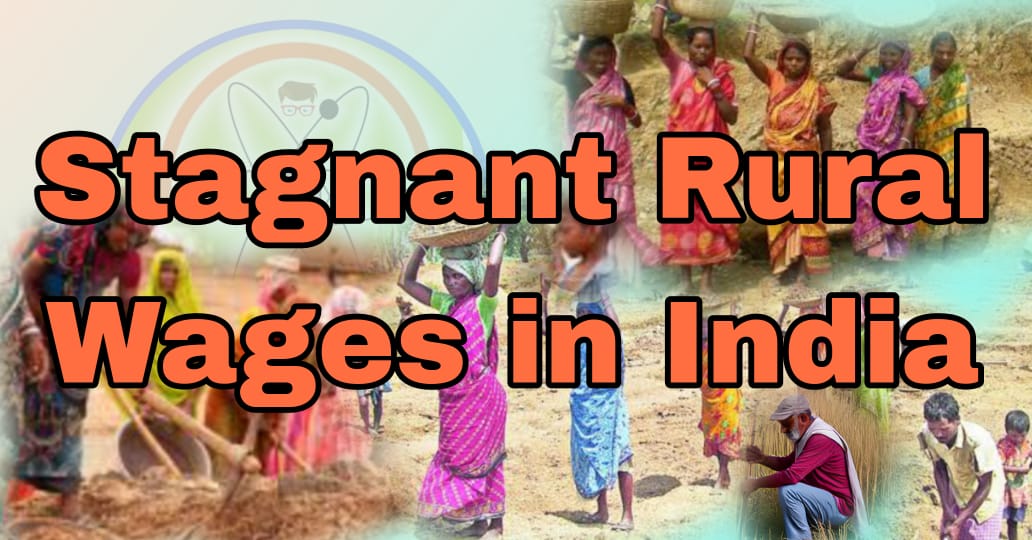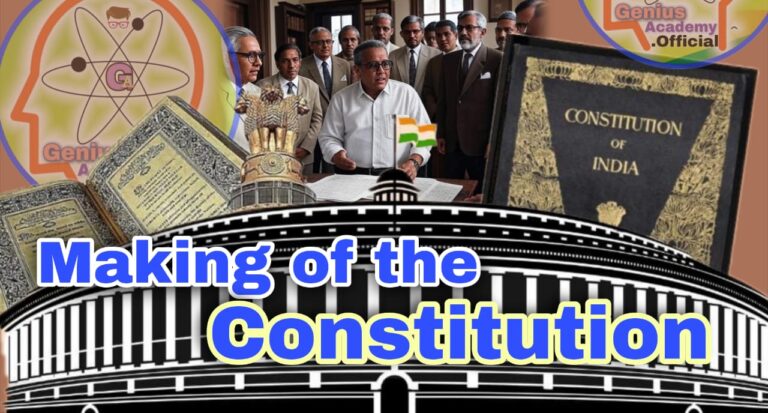Paradox of Stagnant Rural Wages in India
Syllabus: GS3/ Indian Economy : Employment
In Context
In recent years, India’s economy has experienced robust growth. However, this expansion has not been mirrored by proportional wage growth in rural areas. Data from the Labour Bureau indicates varying trends in daily wage rates for both agricultural and non-agricultural jobs, suggesting that wage growth across sectors is uneven. The Wage Rate Index (WRI) further highlights these disparities, underlining a significant gap in income progression for rural workers despite the country’s economic gains.
Current State of Rural Wages in India
- Economic Growth Versus Wage Growth: From 2019 to 2023, India’s GDP has grown at an average rate of 4.6% per year, with the agricultural sector also showing steady growth at 4.2%. However, rural wages have not risen in proportion to this growth, leading to a paradox where economic expansion has not translated into enhanced income for rural laborers.
- Nominal Wage Growth: Between April 2019 and August 2024, rural wages grew by an average of 5.2% annually in nominal terms, while agricultural wages showed slightly higher growth at 5.8%. Although these figures suggest growth on paper, they do not reflect the actual purchasing power of rural workers.
- Real Wage Growth After Inflation: When adjusted for inflation, real wage growth for rural workers reveals a decline. Overall, real wages for rural laborers have decreased by -0.4%, with agricultural wages rising by only 0.2%. This decline indicates that inflation has significantly outpaced wage growth, eroding the purchasing power of rural workers and leaving them financially constrained.
- Recent Wage Trends in 2023-24: In the months from April to August 2023, agricultural wages saw nominal growth of 5.7%. However, after adjusting for inflation, the real growth rate was only 0.7%. This recent trend reinforces the impact of inflation on rural income, as the minimal increase in real wages fails to keep pace with rising costs of living.
Factors Contributing to Stagnant Rural Wages
- Higher Female Workforce Participation: The Labor Force Participation Rate (LFPR) for women in rural India has increased significantly, from 26.4% in 2018-19 to 47.6% in 2023-24. While this indicates an encouraging shift toward greater female employment, it also means more people are seeking work, which can keep wages low due to increased competition in a job market with limited demand.
- Low Agricultural Productivity: Simply increasing the workforce in agriculture does not necessarily boost productivity. Many rural jobs are seasonal or low-paying, with limited opportunity for efficiency improvements, which keeps wage levels stagnant even as more individuals are employed.
- Technological Advances in Agriculture: The use of machines like threshers and harvesters has reduced the need for manual labor in agriculture. While mechanization helps improve efficiency, it limits job creation, especially for unskilled workers, resulting in fewer opportunities and stagnant wages for rural laborers.
- Reduced Demand for Non-Agricultural Labor: Industries that traditionally hire rural workers, such as Fast-Moving Consumer Goods (FMCG) and small manufacturing units, have faced slower growth and reduced profitability. This economic slowdown has led to fewer job opportunities in these sectors, further contributing to wage stagnation.
- Limited Non-Farm Job Opportunities: Non-farm jobs in rural areas, such as those in small-scale industries, remain underdeveloped due to lack of investment and inadequate financial support. This restricts job creation outside agriculture, limiting the potential for wage growth.
- Weaknesses in Wage Guarantee Programs: Wage guarantee schemes, like the Mahatma Gandhi National Rural Employment Guarantee Act (MGNREGA), are meant to support rural incomes. However, these programs are hampered by issues like delayed payments and budget shortfalls, reducing their effectiveness in helping rural workers achieve a stable income.
- Impact of Inflation on Essential Goods: The rising costs of essential goods, such as food and fuel, have significantly outpaced wage growth. This inflationary pressure has decreased rural workers’ real income, worsening financial insecurity and limiting their ability to cover basic expenses.
- Effects of Climate Change: Climate change impacts, including extreme weather events such as droughts and floods, have reduced agricultural productivity and, by extension, farmer incomes. This reduction in earnings often makes it difficult for landowners to offer higher wages to their workers.
Implications of Stagnant Rural Wages
- Reduced Demand for Goods and Services: Low wage growth in rural areas means that households have less money to spend on goods and services, limiting demand. This reduction in demand affects small businesses and service providers, ultimately slowing economic growth.
- Increased Financial Strain and Debt: The combination of low wages and high inflation has forced many rural families into debt. In the absence of formal credit options, rural households often turn to informal lenders, resulting in debt cycles that perpetuate financial insecurity.
- Underemployment in Rural Areas: The scarcity of non-agricultural jobs means many rural workers resort to low-productivity farming activities. This underemployment limits rural workers’ potential to earn higher incomes and reduces overall economic productivity.
- Widening Gender Pay Gap: Stagnant wages affect both men and women, but the impact is more pronounced for women who already earn less on average. The gender pay gap in rural areas exacerbates financial challenges for women and their families.
- Migration to Urban Centers: Limited job opportunities in rural areas push many individuals to migrate to cities in search of work. This rural-to-urban migration places strain on urban infrastructure, contributing to overcrowding and putting pressure on city resources.
- Decline in Human Capital Development: Low wages limit the ability of rural families to invest in education, healthcare, and nutrition. This underinvestment in human capital impacts long-term development and reduces economic opportunities for future generations.
Strategies to Address Rural Wage Stagnation
- Strengthen Income Support Programs: Expanding and enhancing income support programs like PM-KISAN, along with food distribution schemes, can alleviate immediate financial pressure on rural families. These initiatives can provide a safety net, improving overall income security.
- Adjust Wages for Inflation Regularly: Periodic adjustments of rural wages to match inflation rates are essential to ensure that wage levels keep up with the rising cost of living. Such adjustments would help rural workers maintain their purchasing power.
- Reduce Gender Wage Gap: Programs aimed at reducing the gender pay gap, such as Maharashtra’s Ladki Bahin Yojana, which provides financial assistance to low-income families, could support economic security for women and encourage more equitable wage distribution.
- Promote Rural Non-Farm Employment: Encouraging labor-intensive industries like textiles, food processing, and tourism can create diverse job opportunities in rural areas. Programs like MGNREGA can also help maintain income levels during times of seasonal unemployment in the agricultural sector.
- Modernize Agriculture to Improve Productivity: Investing in agricultural modernization, such as better-quality seeds, improved irrigation, and advanced farming techniques, can increase productivity and income, supporting higher wages within the sector.
Key Institutions and Indicators
- Labour Bureau: The Labour Bureau, under the Ministry of Labour & Employment, headquartered in Chandigarh, plays a crucial role in gathering and analyzing labor, employment, and price data. It provides primary data for important economic indicators like the Consumer Price Index for Industrial Workers and various wage indices.
- Wage Rate Index (WRI): The Wage Rate Index (WRI), compiled by the Labour Bureau, follows guidelines from the International Labour Organization (ILO) and the National Statistical Commission. The WRI is updated semi-annually, expanding coverage to include a wider range of occupations and industries. It provides a comprehensive measure of wage trends, helping policymakers assess wage dynamics and address income inequalities.
Conclusion
This overview highlights the main causes, implications, and potential solutions for rural wage stagnation in India. Addressing these issues will require targeted policy actions to support rural income growth and provide rural communities with sustainable economic opportunities.
Source : – Indian Express
Short Notes:
| Current Rural Wage Trends: – GDP grew at 4.6% (2019–2023), but rural wages lag behind. – Nominal Wage Growth (2019–2024): Rural wages grew 5.2% annually, but real wages declined due to inflation (-0.4% overall, 0.2% in agriculture). – Recent Trends (2023–24): Agricultural wages grew 5.7% nominally but only 0.7% after inflation. Factors Contributing to Stagnation: 1. Higher Female Workforce Participation : Increased competition for jobs keeps wages low. 2. Low Agricultural Productivity : Seasonal, low-paying jobs. 3. Technological Advances: Mechanization reduces manual labor demand. 4. Reduced Non-Agricultural Demand: Industries like FMCG and manufacturing face slow growth. 5. Limited Non-Farm Opportunities: Underdeveloped small-scale industries. 6. Weak Wage Guarantee Programs: Issues like delayed payments in MGNREGA. 7. Inflation: Rising costs of essentials erode purchasing power. 8. Climate Change: Droughts and floods reduce agricultural incomes. Implications: 1. Reduced Demand: Low wages limit spending, slowing economic growth. 2. Financial Strain: High debt among rural families. 3. Underemployment: Reliance on low-productivity jobs. 4. Gender Pay Gap: Stagnation worsens inequality for women. 5. Urban Migration: Pressure on cities due to lack of rural jobs. 6. Decline in Human Capital: Limited investment in education and healthcare. Strategies to Address Stagnation : 1. Strengthen income support programs like PM-KISAN. 2. Adjust wages for inflation periodically. 3. Reduce the gender wage gap through targeted programs. 4. Promote rural non-farm employment in textiles, tourism, etc. 5. Modernize agriculture with better techniques and irrigation. Key Institutions and Indicators: Labour Bureau: Collects data on employment and wages. Wage Rate Index (WRI): Tracks wage trends to aid policy decisions. |
Daily Mains Practice Question
| [1.] Despite robust economic growth, rural wages in India have remained stagnant. Critically analyze the reasons for this paradox and suggest policy measures to address the issue. |
| [2.] Low rural wage growth has broad socio-economic consequences. Discuss how it impacts demand for goods, financial strain, and rural-urban migration. Suggest solutions to tackle these challenges. |
| [3.] Suggest a comprehensive policy framework to address rural wage stagnation in India, focusing on inflation adjustment, employment generation, and human capital development |






